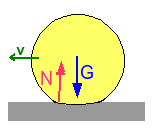Traction (drive)
Traction ( Latin trahere , drag 'pull') referred to in any type of vehicles their powered locomotion. In the physical sense, it is a form of tensile force that is converted into rotation when overcoming rolling resistance to move loads. A factor to be calculated in the process of movement is the traction coefficient, a technical quantity, a quotient of the forces used for movement and the load being moved. Achieving a low coefficient of traction is equally important for the maintenance and manufacturing industries of vehicles and accessories as well as for transportation companies .
literature
- Hans-Hermann Braess, Ulrich Seiffert (Hrsg.): Vieweg manual automotive technology. 6th edition, Vieweg + Teubner Verlag, Wiesbaden 2011, ISBN 978-3-8348-1011-3 .
- Wolfgang Schiemann: Rail transport technology. Basics of track alignment, 1st edition, BG Teubner, Wiesbaden 2002, ISBN 978-3-519-00363-2 .
Web links
- Front or rear wheel drive, tandem or twin (accessed February 15, 2016)
- Change in wheelset load on locomotives due to traction (accessed on February 15, 2016)
